Daily Current Affairs (CA) for UPSC 14th Oct 2025




| Index |
| S.No | Topic | Page No |
| Daily Hindu Analysis (YouTube) |
| 1. | Estimating India’s potential growth rate |
|
| 2. | The need to address caste-based atrocities |
|
| 3. | Snow leopards are the world’s least genetically diverse big cat |
|
| 4. | Arctic seals, birds in new 'red list' of endangered species: IUCN |
|
| 5. | Retail inflation hits 8-year low of 1.54% in Sept |
|
| 6. | Number of births declines; deaths rise slightly: report |
|
| 7. | Even on 'clear' days, the air can still be chemically toxic |
|
| Daily Current Affairs |
| 8. | IUCN’s World Commission on Protected Areas |
|
| 9. | Maitri II Station |
|
| 10. | IUCN World Heritage Outlook 2025 |
|
| 11. | International Purple Fest 2025 |
|
| 12. | UNESCO Launches the World’s First Virtual Museum of Stolen Cultural Objects |
|
Estimating India’s potential growth rate
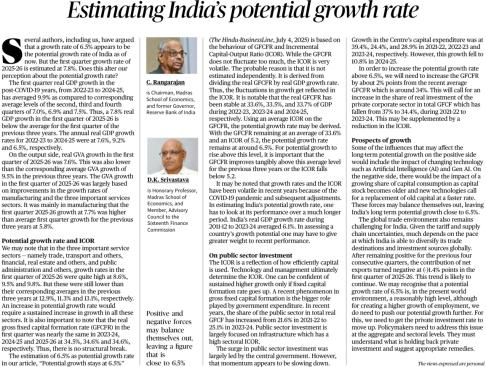
Syllabus Mapping
- GS Paper III:
- Indian Economy – Growth and Development
- Inclusive Growth and Investment Models
- Mobilization of Resources
- Effects of Liberalization on the Economy
Context Recent estimates suggest that India’s potential growth rate—the maximum sustainable rate of growth without triggering inflation—is around 6.5%, while the first-quarter GDP growth (2025–26) stood at 7.8%.
This raises questions about whether India is growing above its potential and what structural reforms are needed to sustain high growth in the long term.
What is Potential Growth Rate?
- It represents the maximum level of real GDP growth an economy can achieve using available resources efficiently without causing inflationary pressures.
- Determined by factors like investment rate, capital efficiency, labour productivity, and technological progress.
Key Data Points from the Article- GDP Growth (Q1 2025–26): 7.8%, lower than the average 9.9% in the past three years.
- Average Annual GDP Growth (2022–25): 7.6%, 9.2%, and 6.5%.
- Gross Fixed Capital Formation (GFCF): Averaged around 34.5% of GDP (2023–26).
- Incremental Capital Output Ratio (ICOR): Around 5.2 — meaning more investment is needed per unit of output compared to earlier years.
Analysis: Growth vs Potential - The GVA growth (7.6%) in Q1 2025–26 was below the 9.5% average of the previous three years, showing a slowdown in momentum.
- Manufacturing grew 7.7%, better than the previous three-year average of 5.8%, but services and agriculture showed moderation.
- The potential growth rate depends on both the investment rate (GFCF) and the efficiency of capital (ICOR).
Determinants of India’s Potential Growth
1. Investment and Capital Formation
- Public sector investment rose to 25% of GDP in FY25 (from 21.6% in FY22), but private investment remains subdued.
- Sustained growth needs revival of private capital expenditure and higher productivity of investment.
2. ICOR and Efficiency - A lower ICOR indicates higher capital efficiency.
- India’s ICOR at 5.2 suggests inefficiency compared to earlier periods when it was near 4.
- To achieve potential growth >6.5%, India needs to reduce ICOR and maintain investment ratio near 34%.
3. Public Expenditure and Reforms - Higher government spending has supported infrastructure growth.
- Fiscal prudence and efficient utilization of funds are essential to sustain momentum without overheating the economy.
4. Technological Innovation - Adoption of Artificial Intelligence (AI), Gen AI, and digital infrastructure can improve productivity and push long-term growth.
Global and Domestic Challenges - External headwinds: Global slowdown, trade tensions, high interest rates in developed economies.
- Domestic constraints: Weak private investment sentiment, uneven monsoon affecting agriculture, and capital inefficiency.
UPSC Mains Question Q.
“India’s potential growth rate hinges not just on the pace of investment but on the efficiency of capital and productivity gains.” Examine in the context of recent economic trends.
The need to address caste-based atrocities
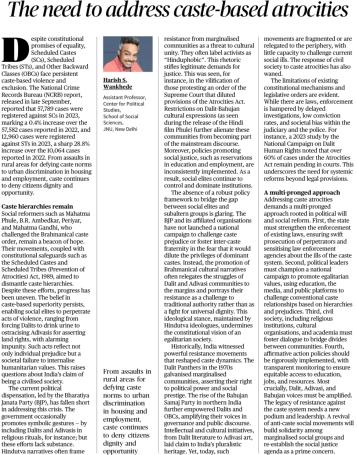
Syllabus Mapping - GS Paper I: Indian Society – Diversity, Social Empowerment, Caste System
- GS Paper II: Welfare Schemes for Vulnerable Sections, Social Justice, Role of Civil Services in Democracy
Context Despite decades of affirmative action and constitutional safeguards, caste-based violence and discrimination remain persistent challenges in India.
The National Crime Records Bureau (NCRB) 2023 report reveals a 0.4% increase in crimes against Scheduled Castes (SCs) and a 28.8% increase against Scheduled Tribes (STs) over 2022 figures — indicating continuing structural and social exclusion.
Current Scenario
- Over 57,789 cases were registered under the SC/ST (Prevention of Atrocities) Act, 1989 in 2023.
- Crimes include assaults in rural areas for defying caste norms, denial of housing or jobs in urban settings, and systemic exclusion in education and governance.
- Low conviction rates and delayed investigations weaken the deterrence of existing legal provisions.
Constitutional and Legal Safeguards 1. Articles 15 & 17 – Prohibit discrimination and abolish untouchability. 2. Article 46 – Directs the State to promote educational and economic interests of SCs and STs.
3. Scheduled Castes and Scheduled Tribes (Prevention of Atrocities) Act, 1989 – Provides stringent measures against caste-based violence
4. Protection of Civil Rights Act, 1955 – Penalises denial of access to public spaces and resources.
5. National Commissions for SCs and STs – Monitor implementation of constitutional and statutory safeguards.
Government Initiatives
1. Legal and Administrative
- Stand-Up India Scheme: Encourages entrepreneurship among SC/ST and women entrepreneurs.
- Ambedkar Social Innovation and Incubation Mission (ASIIM): Promotes innovation and startups among SC youth.
- Dr. Ambedkar Foundation (DAF): Conducts research and awareness programs to promote social harmony.
- Pradhan Mantri Anusuchit Jaati Abhyuday Yojana (PM-AJAY): Integrates welfare schemes for SCs through education, housing, and livelihood.
- Vanbandhu Kalyan Yojana: Enhances livelihood, education, and infrastructure for STs.
2. Economic Empowerment - National SC/ST Finance and Development Corporations: Provide concessional loans and financial support.
- Pradhan Mantri Adarsh Gram Yojana (PMAGY): Converts SC-dominated villages into “model villages” through infrastructure and social development.
3. Social Empowerment - National Action Plan for SC Children (2023): Focuses on education, skill development, and healthcare.
- Pre-Matric and Post-Matric Scholarships: Promote educational advancement among SC/ST students.
- Bhimrao Ambedkar Samajik Adhikarita Portal: Ensures transparency in welfare scheme implementation.
4. Institutional Mechanisms - National Commission for Scheduled Castes (NCSC) and National Commission for Scheduled Tribes (NCST): Monitor rights and recommend policy measures.
- National Campaign on Dalit Human Rights (NCDHR): Advocates legal and institutional accountability for atrocity cases.
Key Issues Highlighted - Weak Implementation: Legal frameworks exist but are poorly executed — over 60% of cases under the Atrocities Act remain pending in courts (NCDHR Report 2023).
- Cultural Resistance: Assertion by Dalit and Adivasi communities is often misrepresented as “threats to cultural unity” or “Hinduphobia.”
- Social Bias: Judicial and police systems often reflect societal prejudice, leading to under-reporting and acquittals.
- Absence of Policy Cohesion: Social justice policies like reservation lack consistency and synergy with broader anti-discrimination measures.
UPSC Mains Q.
“Despite strong constitutional and legal safeguards, caste-based atrocities continue to persist in India. Critically analyse the reasons and suggest systemic measures to address this enduring challenge.”
Snow leopards are the world’s least genetically diverse big cat 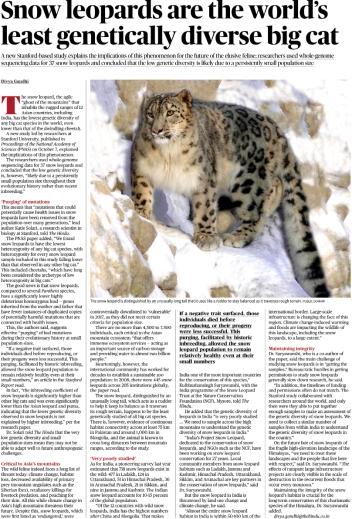
Syllabus Mapping
- GS Paper III:
- Environment and Ecology – Conservation of Biodiversity
- Environmental Pollution and Degradation
- Climate Change and Wildlife Protection
Context A recent study by researchers at Stanford University, published in the
Proceedings of the National Academy of Sciences (PNAS, October 2025), found that the snow leopard (
Panthera uncia) — often called the “ghost of the mountains” — has the lowest genetic diversity among all big cats, even lower than the cheetah.
This genetic uniformity is attributed to a persistently small population size over evolutionary history, rather than recent inbreeding.
What the Study Found
- Researchers conducted whole-genome sequencing of 37 snow leopards across 12 Asian countries (including India).
- Findings reveal very low heterozygosity — an indicator of genetic diversity — suggesting a small effective population size for thousands of years.
- However, the species avoided harmful health effects due to a “purging of mutations” over time — where individuals with harmful traits did not reproduce, maintaining population stability.
Implications of Low Genetic Diversity - Reduced adaptability: Low diversity limits the ability to cope with environmental and climatic changes.
- Vulnerability to disease: Genetic uniformity increases susceptibility to pathogens.
- Risk under climate change: Rapid habitat alterations in the Himalayas and Central Asia may severely affect survival and reproduction.
Population and Distribution - Global population: 4,500–7,500 individuals.
- Indian population: Around 718 individuals (2023 estimate), found mainly in Ladakh, Himachal Pradesh, Uttarakhand, Arunachal Pradesh, and Sikkim.
- Habitats: Alpine and subalpine zones between 3,000–5,000 metres, critical to the Himalayan ecosystem.
Conservation Status - IUCN Red List: Vulnerable (downlisted from Endangered in 2017).
- CITES: Appendix I (trade prohibited).
- Wildlife (Protection) Act, 1972: Schedule I species in India (maximum protection).
Conservation Efforts in India 1. Project Snow Leopard (2009):
- Ministry of Environment, Forest and Climate Change (MoEFCC) initiative to safeguard snow leopard habitats across the Himalayas.
- Focus on community-based conservation, eco-development, and habitat restoration.
2. SECURE Himalaya Project (UNDP–GEF Partnership): - Strengthens sustainable livelihoods and ecosystem resilience in Himachal Pradesh, Uttarakhand, Sikkim, and Jammu & Kashmir.
3. National Mission on Himalayan Studies (NMHS): - Promotes research on climate change impacts and wildlife adaptation in high-altitude ecosystems.
4. State-Level Actions: - Hemis National Park (Ladakh) and Kibber Wildlife Sanctuary (Himachal Pradesh) serve as snow leopard strongholds.
- Community monitoring programs involving local herders and NGOs like WWF and NCF (Nature Conservation Foundation) are active in the Trans-Himalayan belt.
Key Conservation Challenges - Climate change: Glacial melt, shifting vegetation, and reduced prey base.
- Human–wildlife conflict: Livestock depredation leads to retaliatory killings.
- Infrastructure expansion: Roads, hydropower, and tourism threaten fragile mountain habitats.
- Sampling difficulty: Harsh terrain and bureaucratic hurdles hinder genetic and ecological research.
Ecological Importance - Snow leopards are apex predators maintaining prey balance (blue sheep, ibex).
- Their presence indicates ecosystem health in the Himalayas — crucial for carbon storage, water regulation, and biodiversity stability.
UPSC Prelims Q.
Which of the following groups of States/UTs represent the natural habitat of the Snow Leopard (Panthera uncia) in India? (a) Himachal Pradesh, Uttarakhand, Ladakh, Arunachal Pradesh, Jammu & Kashmir, Sikkim
(b) Himachal Pradesh, Nagaland, Punjab, Arunachal Pradesh, Meghalaya, Tripura
(c) Ladakh, Jammu & Kashmir, Rajasthan, Gujarat, Assam, Tamil Nadu
(d) Sikkim, Arunachal Pradesh, Nagaland, Kerala, Mizoram, Goa Correct Answer: (a)
Arctic seals, birds in new 'red list' of endangered species: IUCN
 Syllabus Mapping
Syllabus Mapping - GS Paper III: Environment, Biodiversity, and Climate Change
- Conservation of Flora and Fauna
- Effects of Climate Change on Ecosystems
- International Environmental Conventions and Institutions
Context The International Union for Conservation of Nature (IUCN) released an updated Red List of Threatened Species (2025) during the IUCN World Conservation Congress in Abu Dhabi.
The update highlights the growing threats to Arctic species, especially seals and migratory birds, due to climate change, maritime activity, and habitat loss. The IUCN now lists 172,620 species, of which 48,646 are threatened with extinction, underscoring the accelerating biodiversity crisis.
Key Findings of the 2025 IUCN Report
1. Arctic Species Under Severe Stress
- Hooded Seal: Moved from Vulnerable to Endangered status.
- Bearded and Harp Seals: Newly classified as Near Threatened.
- Cause: Rapid melting of Arctic sea ice — occurring four times faster than the global average.
- Impact: Loss of breeding and feeding habitats; disruption of the Arctic food web.
2. Birds at Risk from Habitat Loss - Global deforestation, agricultural expansion, and logging threaten bird populations.
- 11.5% of 11,185 bird species studied are globally threatened.
- Tropical forests, especially in Madagascar, West Africa, and Central America, remain high-risk zones.
3. Drivers of Extinction - Global warming → reduced sea ice cover, habitat shifts, disrupted breeding cycles.
- Human activities → maritime traffic, oil exploration, and industrial fishing.
- Habitat loss → conversion of forests to farmlands and urban expansion.
Positive Conservation Highlight - Green Turtle has been removed from the Endangered list after decades of sustained conservation.
- Its population has recovered by 28% since the 1970s, proving that long-term global conservation efforts can reverse decline.
Ecological Significance - Seals as keystone species:
- Crucial to Arctic food chains — they regulate populations of fish and invertebrates.
- Their decline threatens predator species like polar bears and the overall marine ecosystem.
- Birds as ecological indicators:
- Reflect health of forest ecosystems and climate conditions.
- Their decline signals deeper disruptions in nutrient cycles and biodiversity balance.
Global Implications - The IUCN Red List serves as the most comprehensive inventory of species conservation status worldwide.
- The 2025 update underscores the climate–biodiversity nexus, showing that the Arctic is among the regions warming fastest on Earth.
- Calls for urgent mitigation of climate impacts, habitat restoration, and sustainable ocean governance.
UPSC Prelims Q.
With reference to the 2025 IUCN Red List update, consider the following statements: 1. The Hooded Seal has been reclassified from Vulnerable to Endangered due to habitat loss caused by melting Arctic sea ice.
2. Bearded and Harp Seals have been downgraded to “Critically Endangered.”
3. The IUCN Red List 2025 includes more than 170,000 species, with nearly 28% threatened with extinction.
4. The Green Turtle’s recovery is cited as an example of successful global conservation. Which of the statements given above are correct?
(a) 1 and 3 only
(b) 1, 3 and 4 only
(c) 2 and 4 only
(d) 1, 2, 3 and 4
Answer: (b) 1, 3 and 4 only
Retail inflation hits 8-year low of 1.54% in Sept

Syllabus Mapping
- GS Paper III:
- Indian Economy – Growth, Inflation, and Monetary Policy
- Government Budgeting and Inclusive Growth
- Effects of Liberalisation on the Economy
Context India’s retail inflation, measured by the Consumer Price Index (CPI), dropped to an 8-year low of 1.54% in September 2025, the lowest since June 2017 (1.46%).
This marks the second consecutive month that inflation has stayed below the Reserve Bank of India’s (RBI) lower comfort band of 2–6%, largely due to a decline in food and fuel prices.
What is Retail Inflation?
- Retail inflation represents the rise in prices of goods and services consumed by households, tracked through the Consumer Price Index (CPI).
- It includes categories like food, fuel, clothing, housing, and transportation.
- It directly affects the purchasing power of consumers and guides RBI’s monetary policy decisions under the inflation-targeting framework.
Key Highlights (MOSPI Data, September 2025) | Parameter | Data / Observation |
| CPI Inflation (All India) | 1.54% (lowest since 2017) |
| Food & Beverages Inflation | -1.4% contraction |
| Fuel & Light Inflation | 1.98% (vs 2.3% in August) |
| Oil & Fats Inflation | 18.3% (11th consecutive month of double digits) |
| Clothing & Footwear Inflation | 2.28% (slightly lower than 2.33% in August) |
| Housing Inflation | 4% (vs 3.1% previous month) |
Reasons for the Fall 1. Decline in Food Prices: o Good monsoon and improved supply chain conditions brought down vegetable and cereal prices.
2. Lower Global Fuel Prices: o Easing of international crude and edible oil prices moderated imported inflation.
3. Base Effect: o High inflation in the corresponding period last year contributed to a lower year-on-year figure.
4. Government Measures: o Supply-side interventions, export curbs on essential items, and reduced fuel taxes.
Economic Implications
- Positive:
- Boosts household purchasing power.
- Supports RBI’s dovish monetary stance, raising hopes for a repo rate cut in December 2025.
- Encourages consumption-driven growth in festive season.
- Cautionary:
- Persistently high double-digit inflation in edible oils and fats remains a concern.
- Any late monsoon withdrawal or extreme weather event could reverse the trend.
- Core inflation (non-food, non-fuel) stability remains critical for long-term price control.
RBI’s Inflation Targeting Framework - Mandated under the Monetary Policy Framework Agreement (2016).
- Target: 4% ± 2% (range 2–6%).
- CPI is the primary measure used for policy rate decisions by the Monetary Policy Committee (MPC).
Global Context - Several economies continue to battle high inflation, while India’s moderation demonstrates effective fiscal–monetary coordination and supply-side resilience.
- However, weak global demand and falling commodity prices signal potential risks of deflationary trends if growth slows further.
UPSC Prelims Question Q.
With reference to Retail Inflation in India, consider the following statements: 1. Retail inflation is measured using the Wholesale Price Index (WPI). 2. The Reserve Bank of India’s inflation target is 4% with a tolerance band of ±2%. 3. Fuel and light categories are included in the Consumer Price Index (CPI). Which of the above statements is/are correct?
(a) 1 and 2 only
(b) 2 and 3 only
(c) 1 and 3 only
(d) 1, 2 and 3
Answer: (b)
Number of births declines; deaths rise slightly: report
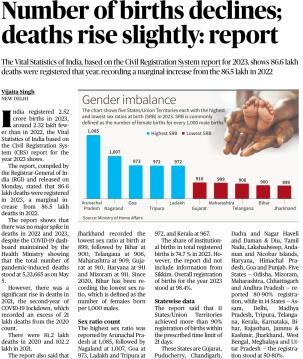
Syllabus Mapping
- GS Paper I: Indian Society – Population and Associated Issues.
Context The Vital Statistics of India 2023, based on the Civil Registration System (CRS) by the Registrar General of India (RGI), shows a decline in registered births and a slight increase in deaths — reflecting India’s ongoing demographic transition.
Key Findings
- Births (2023): 2.52 crore → ↓ 2.32 lakh from 2022.
- Deaths (2023): 86.6 lakh → marginally ↑ from 86.5 lakh in 2022.
- Registration completeness: 98.4%.
- Institutional births: 74.7% of total registered births.
- COVID-19 effect: 2021 saw the highest death count (102.2 lakh); now normalized.
Sex Ratio at Birth (SRB) - Highest SRB: Arunachal Pradesh (1,085), Nagaland (1,007).
- Lowest SRB: Jharkhand (899), Bihar (900), Telangana (906).
- Persistent low SRB in Bihar and Jharkhand shows continued gender imbalance.
State-wise Highlights - High registration (>90%): Gujarat, Kerala, Maharashtra, Tamil Nadu, Telangana.
- Moderate (80–90%): Assam, Delhi, Madhya Pradesh, Rajasthan, Bihar, J&K, etc.
Significance - Indicates India’s movement toward replacement-level fertility (TFR ≈ 2).
- Rising deaths and falling births mark population stabilization.
- Low SRB remains a social concern, reflecting gender bias.
- CRS data is key for public health planning and policy evaluation.
Demographic Transition - Declining births point toward India’s gradual fertility stabilization, consistent with NFHS-5 trends showing TFR near 2.0.
- Suggests India is moving toward a replacement-level fertility rate, marking the onset of population plateauing.
Health and Governance Implications - CRS data informs policy on public health, family planning, and maternal welfare.
- Declining SRB continues to highlight gender bias, sex-selective practices, and social inequality.
- High institutional births reflect improvements under Janani Suraksha Yojana and LaQshya initiative, but rural gaps remain.
Government Schemes - Civil Registration System (CRS): Records births & deaths nationwide.
- Sample Registration System (SRS): Tracks birth/death rates.
- Beti Bachao Beti Padhao (BBBP): Improves child sex ratio.
- Janani Suraksha Yojana (JSY): Promotes institutional deliveries.
- Mission Parivar Vikas: Focuses on family planning and population stabilization.
UPSC Prelims Q.
With reference to the Civil Registration System (CRS) report for 2023, consider the following statements: 1. The report is published annually by the Registrar General of India under the Ministry of Home Affairs.
2. Arunachal Pradesh recorded the highest Sex Ratio at Birth in 2023. 3. Bihar and Jharkhand recorded the lowest SRB values.
4. Institutional births constituted more than 90% of total registered births. Which of the statements given above are correct?
(a) 1, 2 and 3 only
(b) 2 and 4 only
(c) 1, 2, 3 and 4
(d) 1 and 3 only
Answer: (a) 1, 2 and 3 only
Even on 'clear' days, the air can still be chemically toxic

Syllabus Mapping
- GS Paper III: Environment – Pollution and Degradation, Environmental Impact Assessment, Health and Safety.
- GS Paper II: Government policies and interventions for development in health and environment sectors.
Context A new study by East China Normal University, published in
Environmental Health (2025), reveals that air can remain chemically toxic even when PM2.5 levels are within global safety limits.
The research, based on air samples from Shanghai, found that metal-containing fine particles (MCFPs) — especially those rich in iron, manganese, and lead — can cause severe lung cell damage, even when overall particulate concentration appears “safe”.
What is PM2.5?
- PM2.5 refers to particulate matter with a diameter less than 2.5 micrometres.
- These particles can penetrate deep into the lungs and bloodstream, causing respiratory and cardiovascular diseases.
- Traditionally, air quality is assessed by measuring the mass concentration (µg/m³) of PM2.5 in the air.
Key Findings of the Study 1. PM2.5 mass is not the full story:
Air that meets WHO air-quality standards (PM2.5 < 15 µg/m³) can still be chemically harmful.
2. Toxic composition: o Around 80% of metal particles in Shanghai’s air were found to be iron-rich fine particles (MCFPs) containing aluminium, silicon, manganese, and lead. o These metals trigger oxidative stress, damaging DNA and lung cells.
3. Toxicity higher on “clean days”: o Air samples collected on low-PM days caused 8× higher oxidative stress and 6× higher cell death in lab tests compared to high-PM days.
4. Primary sources: o Vehicular emissions and coal combustion were major contributors. o On polluted days, large dust particles dilute the relative concentration of these metal-rich particles. On “clear days,” their proportion rises, making the air chemically more dangerous.
Why This Matters
- The study challenges current air-quality monitoring systems, which rely mainly on total PM2.5 mass.
- It shows that chemical composition — not just particle quantity — determines toxicity.
- Hence, “clear air” can still be biochemically unsafe, leading to chronic lung and cardiovascular issues.
Implications for India - India faces severe PM2.5 pollution, with Delhi, Lucknow, Kanpur, and Kolkata among the world’s worst-affected cities.
- Current monitoring under the National Clean Air Programme (NCAP) measures PM2.5 and PM10 levels but not chemical toxicity or metal content.
- Vehicular emissions, coal-based power plants, and biomass burning are major Indian sources of metal-rich aerosols.
Government Initiatives - National Clean Air Programme (NCAP):
Launched in 2019 to reduce PM2.5 and PM10 concentrations by 40% by 2026 across 131 cities. - Bharat Stage (BS-VI) Emission Norms:
Regulate vehicular pollutants, including particulate emissions and NOx. - Pradhan Mantri Ujjwala Yojana (PMUY):
Reduces indoor air pollution by promoting LPG usage. - National Ambient Air Quality Standards (NAAQS):
Defines permissible limits for major pollutants, including PM2.5 and PM10.
UPSC Prelims Q.
Which of the following statements regarding PM2.5 pollution are correct? 1. PM2.5 particles can enter the human bloodstream and cause DNA damage.
2. The chemical composition of PM2.5 particles determines their toxicity. 3. The National Clean Air Programme (NCAP) in India includes the monitoring of chemical composition of PM2.5. Select the correct answer using the code below:
(a) 1 and 2 only
(b) 2 and 3 only
(c) 1 and 3 only
(d) 1, 2 and 3
Answer: (a)
IUCN’s World Commission on Protected Areas
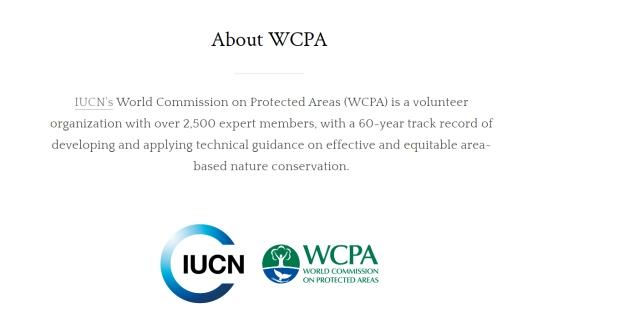
Syllabus: GS Paper 3 – Environment and Biodiversity Conservation
Context: The
Director of Kaziranga National Park and Tiger Reserve has received the
Kenton R. Miller Award, instituted by the
IUCN World Commission on Protected Areas (WCPA), for his innovative contributions to protected area management and sustainability.
Key Points: - About IUCN-WCPA:
- It is one of the six technical commissions of the International Union for Conservation of Nature (IUCN).
- Established in 1948, it is a global network focused on the conservation of nature and sustainable use of natural resources.
- Functions:
- Specializes in protected area governance, management, and policy formulation.
- Supports the creation and effective management of protected areas such as national parks, reserves, and marine protected zones.
- About Kenton R. Miller Award:
- Established in 2006 by the IUCN–WCPA.
- Presented biennially for innovation in national park and protected area sustainability.
- Named after Kenton R. Miller, a former Director General of IUCN.
- Recognizes individuals or teams contributing to innovative planning, management, finance, or governance in conservation.
- Comes with a cash prize of US $5,000.
Source: The Hindu
Maitri II Station Syllabus: GS Paper 3 – Environment and Geography (Polar Research and Climate Studies)
Context: The
Finance Ministry has approved the establishment of
Maitri II, India’s newest
research station in eastern Antarctica, aimed at expanding the country’s scientific presence and promoting sustainable polar research.
Key Points:
- About Maitri II Station:
- It will be larger than Maitri I and designed as a green research base.
- Planned use of renewable energy sources – solar power during summer and wind energy to utilize strong Antarctic winds.
- Equipped with automated instruments to record and relay data to India even when unmanned.
- Expected completion: January 2029.
- Nodal Agency:
- Managed by the National Centre for Polar and Ocean Research (NCPOR) under the Ministry of Earth Sciences (MoES).
- Responsible for organizing India’s Antarctic and Arctic missions.
- About Maitri Station (Existing Base):
- Operational since 1989, located along the Schirmacher Oasis in East Antarctica.
- Facilities include main research blocks, fuel farm, pump house, summer camp, and modular units.
- Accommodates 25–40 scientists, depending on mission needs and season.
- Other Indian Research Bases in Antarctica:
- Dakshin Gangotri: India’s first Antarctic base, now non-operational.
- Bharati: Operational since 2012, serving as a key polar research hub.
Source: Indian Express
IUCN World Heritage Outlook 2025
Syllabus: GS Paper 3 – Environment (Biodiversity Conservation and Climate Change) Context: The IUCN World Heritage Outlook 4 (2025) was launched at the IUCN World Conservation Congress in Abu Dhabi, assessing the conservation status of all natural and mixed UNESCO World Heritage Sites globally. Key Points:
- About the Outlook:
- It is a global assessment system evaluating the state of conservation of all UNESCO natural and mixed World Heritage Sites every 3–5 years.
- Published by: International Union for Conservation of Nature (IUCN) through its World Heritage Programme and World Commission on Protected Areas (WCPA).
- Editions:
- Outlook 4 (2025) follows earlier editions published in 2014, 2017, and 2020.
- Objectives:
- Track conservation health and management effectiveness.
- Recognize best practices and promote knowledge exchange.
- Identify threats such as climate change, invasive species, and governance gaps.
- Global Findings:
- 65% of sites show stable or improving conservation outlook since 2020.
- 80% of natural sites face direct climate risks like coral bleaching and glacier melt.
- 60% experience biodiversity pressure due to habitat loss and invasive species.
- 15 sites added to the “World Heritage in Danger” list due to conflicts and pollution.
- Positive Examples:
- Galápagos Islands and Yellowstone National Park show recovery through ecosystem-based management.
- Komodo (Indonesia) and Aldabra Atoll (Seychelles) improved via sustainable tourism and monitoring.
- AI and satellite mapping enhance forecasting and data-driven conservation.
- Socio-Economic Importance:
- Well-managed heritage sites support livelihoods, carbon sequestration, and disaster resilience.
- Natural sites globally store around 10% of terrestrial carbon.
- Trends in India:
- India has 7 natural and mixed World Heritage Sites, covering 1.5% of global heritage area.
- Improved Sites: Kaziranga and Manas show better ecological health due to restoration and eco-tourism regulation.
- At-Risk Sites: Sundarbans face mangrove decline, while Western Ghats experience land-use conflicts.
- Emerging Concerns: Nanda Devi and Great Himalayan National Park face glacial retreat and invasive species.
- National efforts like the Wildlife (Protection) Amendment Act, 2022 and LiFE Mission align with Global Biodiversity Framework 2030.
- Calls for 30–40% more funding for better monitoring, especially in marine and transboundary zones.
Source: IUCN
International Purple Fest 2025
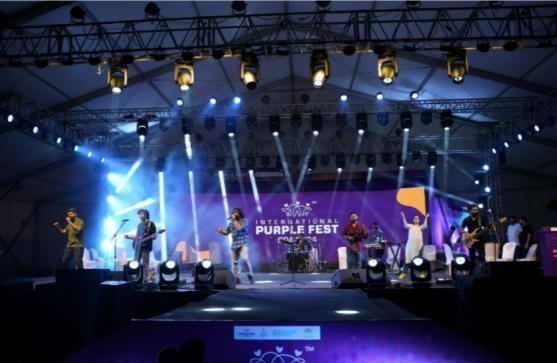
erable Sections) Context: The International Purple Fest 2025 was recently held in Goa, highlighting India’s efforts toward inclusion, accessibility, and empowerment of persons with disabilities (PwDs).
Key Points:
- What it is: A global inclusion festival promoting accessibility and celebrating diversity of PwDs.
- Theme (2025): “Inclusion as a Movement.”
- Venue & Date: Held in Goa from October 9–12, 2025.
- Hosted by: Department for Empowerment of Persons with Disabilities (DEPwD), Government of India.
- Organised by: Office of the State Commissioner for Persons with Disabilities, Government of Goa.
- Collaborating Agencies: Ministry of Social Justice & Empowerment and United Nations India.
- Aim: To mainstream disability inclusion in education, governance, and employment sectors.
- Awareness Goal: To promote empathy and universal design in public infrastructure.
Major Initiatives Launched: - IELTS Training Handbook for PwDs: Developed by Believe in the Invisible (BITI) with DEPwD support; first inclusive manual for IELTS aspirants with visual, hearing, or locomotor disabilities.
- Recognition of Prior Learning (RPL) in ISL Interpretation: Conducted by Indian Sign Language Research and Training Centre (ISLRTC); certified SODA and CODA interpreters.
- Specialized Training in ASL & BSL: Launched by ISLRTC to train Indian interpreters in American and British Sign Languages for international opportunities.
Source: PIB
UNESCO Launches the World’s First Virtual Museum of Stolen Cultural Objects
Syllabus: GS Paper I – Art and Culture (Cultural Heritage and Preservation)
Context: UNESCO launched the
world’s first Virtual Museum of Stolen Cultural Objects during the
MONDIACULT 2025 Conference in
Barcelona, Spain, to promote awareness and restitution of stolen heritage.
Key Points: - What it is: A global digital museum created by UNESCO to document, trace, and display stolen or trafficked cultural artifacts from across the world.
- Launched at: World Conference on Cultural Policies and Sustainable Development (MONDIACULT 2025).
- Organized by: UNESCO (United Nations Educational, Scientific and Cultural Organization).
- Aim:
- Combat illicit trafficking of cultural property through global visibility and education.
- Digitally reconnect nations and communities with their lost cultural heritage.
- Promote ethical museum practices and strengthen heritage education.
Key Features: - 3D and AI-based Platform: Uses 3D modelling, AI, and Virtual Reality (VR) to recreate 240+ missing artifacts from 46 countries.
- Interactive Sections:
- Stolen Cultural Objects Gallery – digital reconstructions of looted items.
- Return and Restitution Room – showcases successful artifact recoveries.
- Auditorium – hosts expert discussions and awareness programs.
- AI Reconstruction: For items lacking images, AI-generated models allow 360° virtual exploration.
- Educational Tools: Include historical background, restoration methods, and anti-trafficking awareness material.
- India’s Representation: Features two 9th-century sandstone sculptures — Nataraja and Brahma from Mahadev Temple, Pali (Chhattisgarh) — stolen during the colonial period.
Source: Indian Express







 Syllabus Mapping
Syllabus Mapping 



